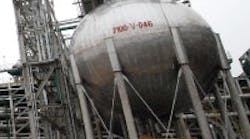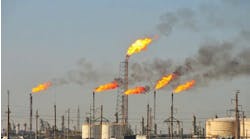By Charlie Henderson
Every project presents different challenges, but sometimes one stands out because of its scale, complexity or schedule. One of these was building the world's largest polysilicon plant for Jiangxi LDK PV Silicon Technology Co. Ltd. (www.LDKSolar.com) in Xinyu City in the People's Republic of China—and doing it in record time. In fact, just 24 months after breaking ground in August 2007, one of the $1.2 billion plant's three production lines produced its first product on Sept. 8, 2009.
Because it is the largest facility of its type anywhere, LDK Solar's polysilicon plant is divided into three major areas: polysilicon production, off-gas recovery and trichlorosilane production (Figure 1). The plant is designed to have an output of 15,000 metric tons per year from its three production lines. In each production line, there are reactors and converters. Production starts with sand, which is processed using hydrochloric acid, and then further purified to produce solar-grade polysilicon. This material is in high demand by photovoltaic cell manufacturers, which is why the plant had to be built so quickly.
Figure 1: This single section of LDK Solar's $1.2 billion polysilicon plant produces trichlorosilanes. The plant's other two major sections handle polysilicon production and off-gas recovery.
Likewise, LDK Solar is a leading manufacturer of multicrystalline solar wafers, which are the principal raw material used to produce solar cells. The company also sells multicrystalline wafers globally to manufacturers of photovoltaic products, including solar cells and solar modules. In addition, LDK Solar also provides wafer processing services to monocrystalline and multicrystalline solar cell and module manufacturers.Spreadsheets Aid Flexible Planning
With such a huge project and such a short time frame, it was clear that normal project schedules (which are based on designing the process, designing and engineering the plant, raising specification sheets for all the instruments and placing orders with suppliers) would not be possible. There simply wasn't time. This fast-track project required our team at Fluor (www.fluor.com) to do things differently. Still, as with any project, we took the three-legged stool approach, which balances quality, cost and speed. We knew that we couldn't compromise on safety or quality, but we were prepared to let speed override cost considerations.
Given the rapid pace of the project design and the repeat setup among the production lines in the process, we had to be flexible in our approach to project planning. During the design, one set of process and instrument drawings (P&IDs) were developed for the first reactor and converter in the polysilicon production area. A P&ID numbering scheme was then developed to allow for sequential numbering of the subsequent reactor and converter P&IDs for the remainder of the polysilicon production lines. For convenience and reference, instrument tag numbers incorporated a portion of the P&ID numbering.
Highly structured, custom spreadsheets rather than the more typical specification sheets were designed and used to organize and order the instrumentation. Spreadsheets helped quickly organize instrumentation requirements, with columns serving as the design parameters necessary to aid in selecting the appropriate model, including process fluid, fluid state, pipe specification, design temperature and pressure, projected flow rates. Spreadsheets also were a good reference for the instrumentation quantities required for each line. The tag numbering sequence was shared with the vendors, so the implied tags for additional quantities were known.
In addition, from prior experience, we knew there would be many instruments requiring SIL 2 ratings. This was also included in the tracking spreadsheet. Changes that cropped up were addressed by a simple revision to the spreadsheet, rather than requiring revision to multiple datasheets.
Finally, the speed of the project required us to begin ordering instrumentation prior to the availability of process data and the results of hazardous operation reviews. Our tracking spreadsheet provided a clear overview, both of what was required and when it was needed for the plant construction phase of the project.
Instrumentation Supplier Selection
It was identified early that the success of this project depended on quality of construction and control system and instrumentation vendor selection. Especially with such a short timeline, supplier selection must be managed carefully. We needed partners with strong technical and engineering support capabilities, and the ability to meet delivery commitments.
As a result, Emerson Process Management's (www.EmersonProcess.com) broad product line, dedicated personnel and experience doing business in China were key factors in its selection by Fluor as the main automation contractor. Within its PlantWeb digital plant architecture, the DeltaV digital automation system would serve as the polysilicon plant's distributed control system (DCS) for process control, its DeltaV SIS process safety system would be used for safety-related I/O, and its AMS Suite maintenance software would be used for managing calibration and diagnostics. Emerson personnel would also be involved in system integration and commissioning. Also, the PlantWeb architecture included Micro Motion Coriolis mass flow and density meters, Rosemount temperature and pressure transmitters, and Fisher control valves (Figure 2).
Importance of Flow Measurement
The fast-track pace of the project, coupled with the requirement for almost 2000 flow data points, necessitated that we use flow technologies with which we had experience and which we knew could meet the many plant requirements. The aggressive planning timelines meant we had to deal quickly with undefined process data, while balancing this against known plant and operational constraints.
Figure 2: Two typical liquid flow measurement processes at LDK Solar's polysilicon plant show how Micro Motion's Coriolis flowmeters (right) fit into a congested piping area, use 50:1 turndown to handle pressure drops and maintain SIL 2 safety ratings. Toward the left is a gas flow measurement, upstream of the green valve.
Many of our applications were for demineralized water used for cooling the reactors, where the low conductivity would not allow the use of magnetic flowmeters. Also, the piping around the deposition reactors was congested. Because it was known that space would be at a premium at the facility, differential pressure flow or vortex flowmeters were ruled out, too, because these instruments require significant straight runs of pipe work before and after each instrument.Another factor for consideration was pressure drop. Our process design did not allow for significant differential pressure loss at the flow measurement points. Generally, the closer a meter is to line size, the smaller the drop. We knew that Micro Motion meters have a large, 50:1 turndown, so we could confidently install line size (or one size below) meters and know that they would be able to measure the required flow rate when it was finally specified.
If we'd chosen alternative technologies, which have a lower turndown, we would also have to wait for the final process data before we could select a meter. Lower turndown means that, in order to accurately measure the flow, we would have had to choose a smaller size meter than the Micro Motion meter required for the same application. In addition, this meter would have to be installed between reducers, creating a restriction in the pipe. The resulting pressure drop would very likely have been larger than the 5 psi specified by the process group.
Our experience with the polysilicon process alerted us to a requirement that many safety instruments would need a SIL 2 rating. At that time, Micro Motion Coriolis mass flowmeters were the only Coriolis flow measuring devices rated to this safety level. If we'd used another technology, we'd have needed two measurements in series to meet the SIL 2 rating, and, as we knew, space would simply not permit this.
After we decided to use Micro Motion Coriolis meters, we then passed the established dimensional data and installation requirements to piping designers for development of isometrics—months ahead of customary schedules. We only had to ensure that the meters were installed in their proper orientation.
Summary of Success
Consequently, more than 1800 Micro Motion Coriolis flowmeters were used on LDK's polysilicon project, which is the world's largest concentrated installation of Micro Motion meters. By considering each application and prioritizing production lines, Emerson was able to begin delivering instruments in June 2008, and be ready for the September 2009 start-up.
Emerson's Micro Motion meters made a big contribution to the success of this project. From an installation point of view, the meter was perfectly suited to the application. Availability of dimensional and performance data meant the pipe work team could start work early, and product was delivered on schedule—months ahead of what we expect with a conventional design. Feedback from the site confirms that correct engineering decisions that were made. The engineers have access to accurate mass flow data at every stage of the process, enabling the operation and systems to be optimized to give the best efficiencies.
Figure 3: Only 24 months after breaking ground, Production Line 1 at LDK Solar's polysilicon plant began producing product, such as these polysilicon rods ready for harvest, on Sept. 8, 2009.
LDK's polysilicon project also has been a huge success for all its stakeholders (Figure 3). At the peak of construction, there were more than 8000 craft workers at the jobsite. Their safety record was impeccable, and, in spite of the hurdles, the plant was constructed in a very short time. With the support of Fluor and Emerson's personnel and the technology providers, the commissioning effort has gone smoothly. Production Line 1 is underway, and the result is a world-class facility that will employ many people in a remote region of China.Charlie Henderson is senior control systems design engineer at Fluor Corp.



